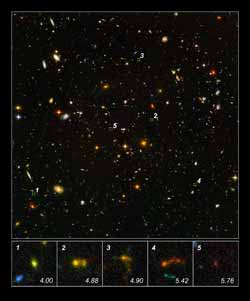Hubble and Spitzer space telescopes find "Lego-block" galaxies in early Universe

In this image of the Hubble Ultra Deep Field, several objects are identified as the faintest, most compact galaxies ever observed in the distant Universe. They are so far away that we see them as they looked less than one billion years after the Big Bang. Blazing with the brilliance of millions of stars, each of the newly discovered galaxies is a hundred to a thousand times smaller than our Milky Way Galaxy. The bottom row of pictures shows several of these clumps (distance expressed in redshift value). Three of the galaxies appear to be slightly disrupted. Rather than being shaped like rounded blobs, they appear stretched into tadpole-like shapes. This is a sign that they may be interacting and merging with neighboring galaxies to form larger structures. The detection required joint observations between Hubble and NASA's Spitzer Space Telescope. Blue light seen by Hubble shows the presence of young stars. The absence of red light from Spitzer observations conclusively shows that these are truly young galaxies without an earlier generation of stars.
Nine Lego-like “building block” galaxies initially detected by Hubble likely contributed to the construction of the Universe as we know it. “These are among the lowest mass galaxies ever directly observed in the early Universe” says Nor Pirzkal of the European Space Agency/STScI.
Pirzkal was surprised to find that the galaxies’ estimated masses were so small. Hubble’s cousin observatory, NASA’s Spitzer Space Telescope was called upon to make precise determinations of their masses. The Spitzer observations confirmed that these galaxies are some of the smallest building blocks of the Universe.
These young galaxies offer important new insights into the Universe’s formative years, just one billion years after the Big Bang. Hubble detected sapphire blue stars residing within the nine pristine galaxies. The youthful stars are just a few million years old and are in the process of turning Big Bang elements (hydrogen and helium) into heavier elements. The stars have probably not yet begun to pollute the surrounding space with elemental products forged within their cores.
“While blue light seen by Hubble shows the presence of young stars, it is the absence of infrared light in the sensitive Spitzer images that was conclusive in showing that these are truly young galaxies without an earlier generation of stars,” says Sangeeta Malhotra of Arizona State University in Tempe, USA, one of the investigators.
The galaxies were first identified by James Rhoads of Arizona State University, USA, and Chun Xu of the Shanghai Institute of Technical Physics in Shanghai, China. Three of the galaxies appear to be slightly disrupted – rather than being shaped like rounded blobs, they appear stretched into tadpole-like shapes. This is a sign that they may be interacting and merging with neighbouring galaxies to form larger, cohesive structures.
The galaxies were observed in the Hubble Ultra Deep Field (HUDF) with Hubble’s Advanced Camera for Surveys and the Near Infrared Camera and Multi-Object Spectrometer as well as Spitzer’s Infrared Array Camera and the European Southern Observatory’s Infrared Spectrometer and Array Camera. Seeing and analysing such small galaxies at such a great distance is at the very limit of the capabilities of the most powerful telescopes.
Images taken through different colour filters with the ACS were supplemented with exposures taken through a so-called grism which spreads the different colours emitted by the galaxies into short “trails”. The analysis of these trails allows the detection of emission from glowing hydrogen gas, giving both the distance and an estimate of the rate of star formation.
These “grism spectra” – taken with Hubble and analysed with software developed at the Space Telescope-European Coordinating Facility in Munich, Germany – can be obtained for objects that are significantly fainter than can be studied spectroscopically with any other current telescope.
Media Contact
More Information:
http://www.spacetelescope.org/news/html/heic0714.htmlAll latest news from the category: Physics and Astronomy
This area deals with the fundamental laws and building blocks of nature and how they interact, the properties and the behavior of matter, and research into space and time and their structures.
innovations-report provides in-depth reports and articles on subjects such as astrophysics, laser technologies, nuclear, quantum, particle and solid-state physics, nanotechnologies, planetary research and findings (Mars, Venus) and developments related to the Hubble Telescope.
Newest articles

Properties of new materials for microchips
… can now be measured well. Reseachers of Delft University of Technology demonstrated measuring performance properties of ultrathin silicon membranes. Making ever smaller and more powerful chips requires new ultrathin…

Floating solar’s potential
… to support sustainable development by addressing climate, water, and energy goals holistically. A new study published this week in Nature Energy raises the potential for floating solar photovoltaics (FPV)…

Skyrmions move at record speeds
… a step towards the computing of the future. An international research team led by scientists from the CNRS1 has discovered that the magnetic nanobubbles2 known as skyrmions can be…





















